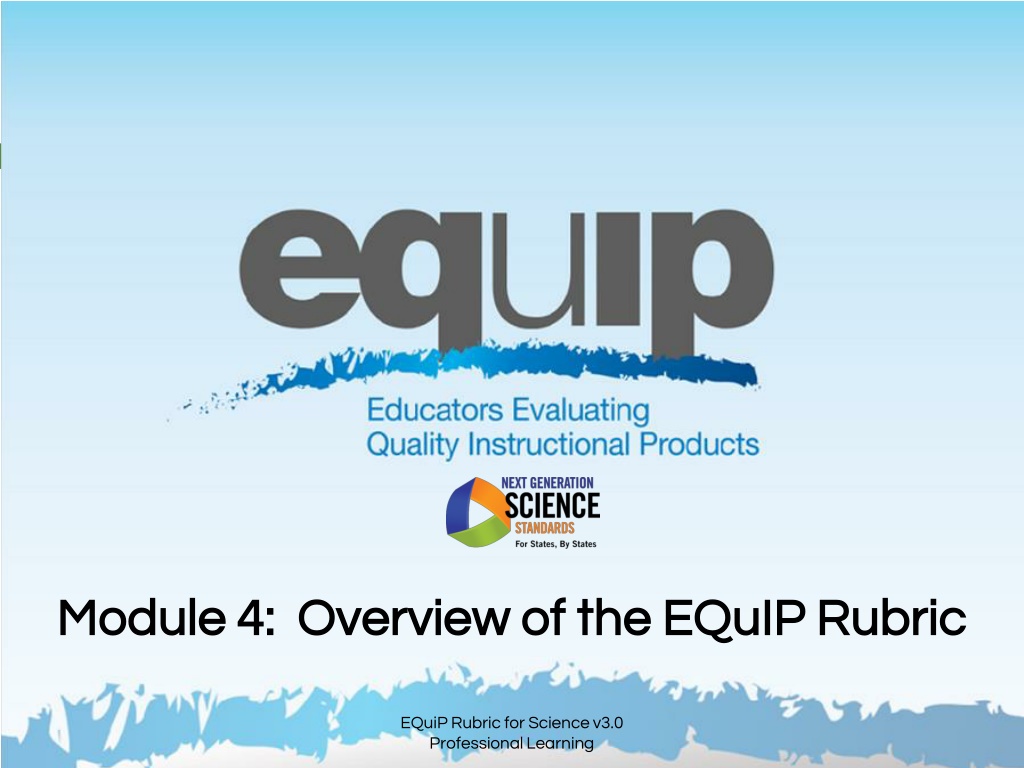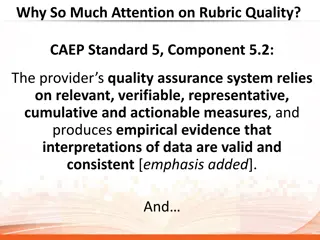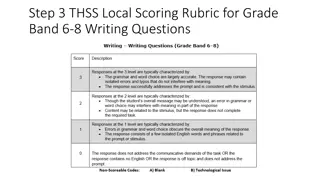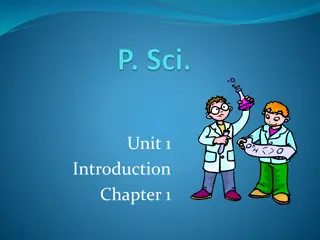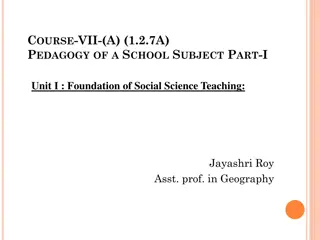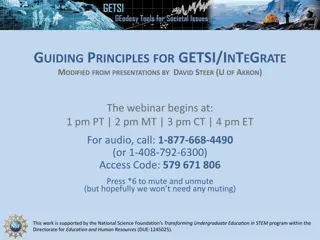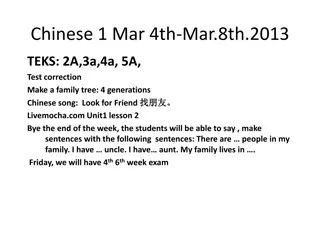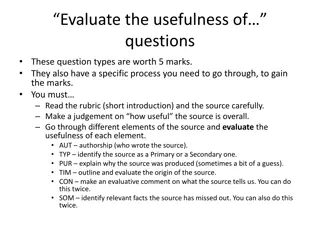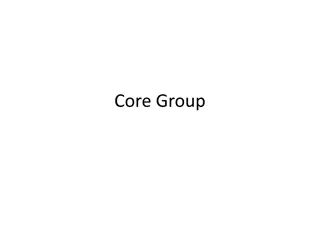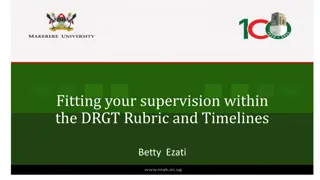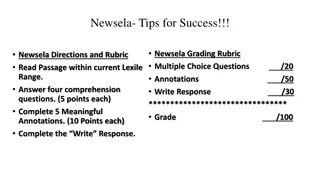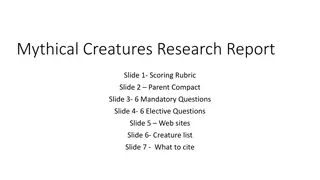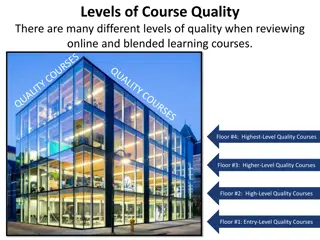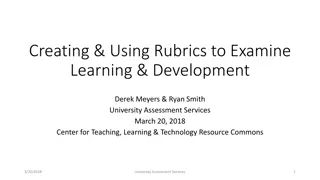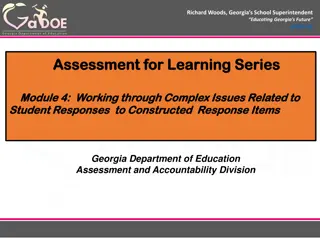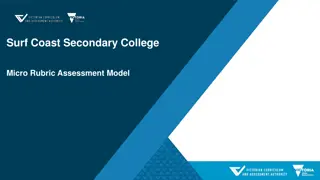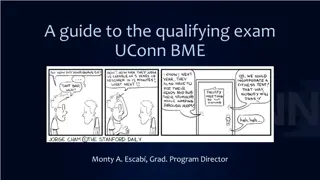Understanding the EQuIP Rubric for Science: A Comprehensive Overview
Delve into the EQuIP Rubric for Science v3.0, exploring its development, structure, history, and key points. Learn about its purposes and objectives, including reviewing lessons, providing feedback, identifying exemplars, and informing new lesson development. Discover the three-category structure of the rubric focusing on NGSS 3-D design, instructional supports, and student progress.
Download Presentation

Please find below an Image/Link to download the presentation.
The content on the website is provided AS IS for your information and personal use only. It may not be sold, licensed, or shared on other websites without obtaining consent from the author. Download presentation by click this link. If you encounter any issues during the download, it is possible that the publisher has removed the file from their server.
E N D
Presentation Transcript
Click to edit Master title style Module 4: Overview of the EQuIP Rubric Module 4: Overview of the EQuIP Rubric EQuiP Rubric for Science v3.0 Professional Learning
Module 4: Overview of the EQuIP Rubric Who developed the EQuIP Rubric and why? What are the purposes and objectives for using the EQuIP Rubric? How is the EQuIP Rubric structured?
History of the EQuIP Rubric EQuIP Educators Evaluating the Quality of Instructional Products
A Few Important Points The Equip Rubric IS The Equip Rubric IS NOT Designed to evaluate LESSONS that include instructional tasks and assessments aligned to NGSS Designed to evaluate a single task or activity or a full curriculum Designed to evaluate UNITS that include integrated and focused lessons aligned to the NGSS that extend over a longer period of time Designed to require a specific template for lessons or units
Purposes & Objectives of the EQuIP Rubric 1. Review existing lessons and units to determine what revisions are needed; 2. Provide constructive criterion-based feedback and suggestions for improvement to developers; 3. Identify exemplars/models for teachers use within and across states; and 4. Inform the development of new lessons and units.
EQuIP Quality Review Agreements 1. 2. 3. 4. 5. 6. 7. NGSS Inquiry Respect & Commitment Criteria & Evidence Constructive Individual to Collective Understanding & Agreement
The Three-Category Structure of the Rubric Category I Category II Category III NGSS 3-D Design NGSS Instructional Supports Monitoring NGSS Student Progress The lesson/unit is designed so students learn the three dimensions of the NGSS through three-dimensional student performances that engage students in making sense of phenomena and/or to design solutions to problems. Lessons and units designed for the NGSS include the following: The lesson/unit supports instruction and learning for all students by placing the lesson in a sequence of learning for all three dimensions and providing support for teachers to engage all students in three dimensional learning. Lessons and units designed for the NGSS include the following: The lesson/unit supports three dimensional learning by providing feedback to students and teachers about student progress across all three dimensions. Lessons and units designed for the NGSS include the following: A. 3D student performances B. Formative assessments C. Scoring guidance D. Unbiased tasks/items A. Relevance and Authenticity B. Student Ideas C. Building Progressions D. Scientific Accuracy E. Differentiated Instruction A. Explaining phenomena/designing solutions B. Three dimensions C. Integrating the Three Dimensions
The Three-Category Structure of the Rubric Category I Category II Category III NGSS 3-D Design The lesson/unit is designed so students learn the three dimensions of the NGSS through three-dimensional student performances that engage students in making sense of phenomena and/or to design solutions to problems. Lessons and units designed for the NGSS include the following: A. Explaining phenomena/designing solutions B. Three dimensions C. Integrating the Three Dimensions
The Three-Category Structure of the Rubric Category I Category II Category III NGSS Instructional Supports The lesson/unit supports instruction and learning for all students by placing the lesson in a sequence of learning for all three dimensions and providing support for teachers to engage all students in three dimensional learning. Lessons and units designed for the NGSS include the following: A. Relevance and Authenticity B. Student Ideas C. Building Progressions D. Scientific Accuracy E. Differentiated Instruction
The Three-Category Structure of the Rubric Category I Category II Category III Monitoring NGSS Student Progress The lesson/unit supports three dimensional learning by providing feedback to students and teachers about student progress across all three dimensions. Lessons and units designed for the NGSS include the following: A. 3D student performances B. Formative assessments C. Scoring guidance D. Unbiased tasks/items
The Three-Category Structure of the Rubric Category I Category II Category III NGSS 3-D Design NGSS Instructional Supports Monitoring NGSS Student Progress The lesson/unit is designed so students learn the three dimensions of the NGSS through three-dimensional student performances that engage students in making sense of phenomena and/or to design solutions to problems. Lessons and units designed for the NGSS include the following: The lesson/unit supports instruction and learning for all students by placing the lesson in a sequence of learning for all three dimensions and providing support for teachers to engage all students in three dimensional learning. Lessons and units designed for the NGSS include the following: The lesson/unit supports three dimensional learning by providing feedback to students and teachers about student progress across all three dimensions. Lessons and units designed for the NGSS include the following: A. 3D student performances B. Formative assessments C. Scoring guidance D. Unbiased tasks/items A. Relevance and Authenticity B. Student Ideas C. Building Progressions D. Scientific Accuracy E. Differentiated Instruction A. Explaining phenomena/designing solutions B. Three dimensions C. Integrating the Three Dimensions
Module 4 Reflection Who developed the EQuIP Rubric and why? What are the purposes and objectives for using the EQuIP Rubric? How is the EQuIP Rubric structured?
